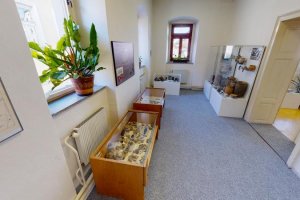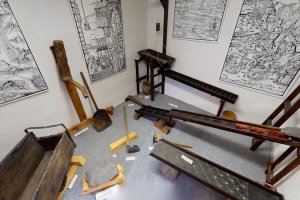History of Rýmařov
In the first hall of the museum, the visitor can see several finds related to the Stone, Bronze and Iron Ages. However, they mostly do not belong to Rýmařov by origin, but come from different parts of northern Moravia. The oldest object found in Rýmařov is a Roman coin from the 1st century A.D. In the same room finds from the suburban settlement are also presented. They are divided according to different phases of settlement - Slavic and later German. The history of Rýmařov continues in the next hall, where finds from the founding of the town (1370s) to the 15th century are presented. Among other things, there are showcases dedicated to the beginnings of the city, the Hrádek fortress, and also the nearby Strálek Castle. In the third hall, the visitor can learn about the Renaissance period in the Rýmařov Region. Most of the exhibits relate to the castle in Janovice and the then owners of the Janovice manor - the Hoffman family of Grünbüchl. The exposition continues with the 18th and 19th centuries in the corridor.
Geology of the southern Jeseníky Mountains
It demonstrates both the variety of minerals, minerals and rocks of the Jeseníky Mountains, as well as their use in construction and ironwork. The geological exhibition continues with a freely accessible external exhibition in the locality of Hrádek near the square.
Textile industry in the Rýmařov Region
In the exposition you can see a set of church silk brocades, a set of priestly chasubles woven with gold and silver, part of the production of Hedva Rýmařov (today Hedva Český Brokát) and a number of tools and machines for processing textiles and textile raw materials. The visitor will learn about the history of the textile industry in Rýmařov from its beginnings in the 18th century to the present day.
Mining in the Rýmařov Region
Finds from the 14th to the 20th century are on display, such as mining hammers, drills, burners and a whole range of other items related to mining. The walls are decorated with the coats of arms of the surrounding villages and towns with a mining theme (e.g. Horní Město, Skály, Bruntál) and copies of the illustrations for the chapters on gold panning from Agricola's Twelve Books on Mining and Metallurgy (the original book dates from the mid-16th century). The exhibition closes with a detailed map of the surroundings of the town of Rýmařov, on which the places of metal mining are marked that were mined here during the 13th to 20th century.
photo gallery

 English (United Kingdom)
English (United Kingdom)  Polski (PL)
Polski (PL)  Czech (Čeština)
Czech (Čeština) 















